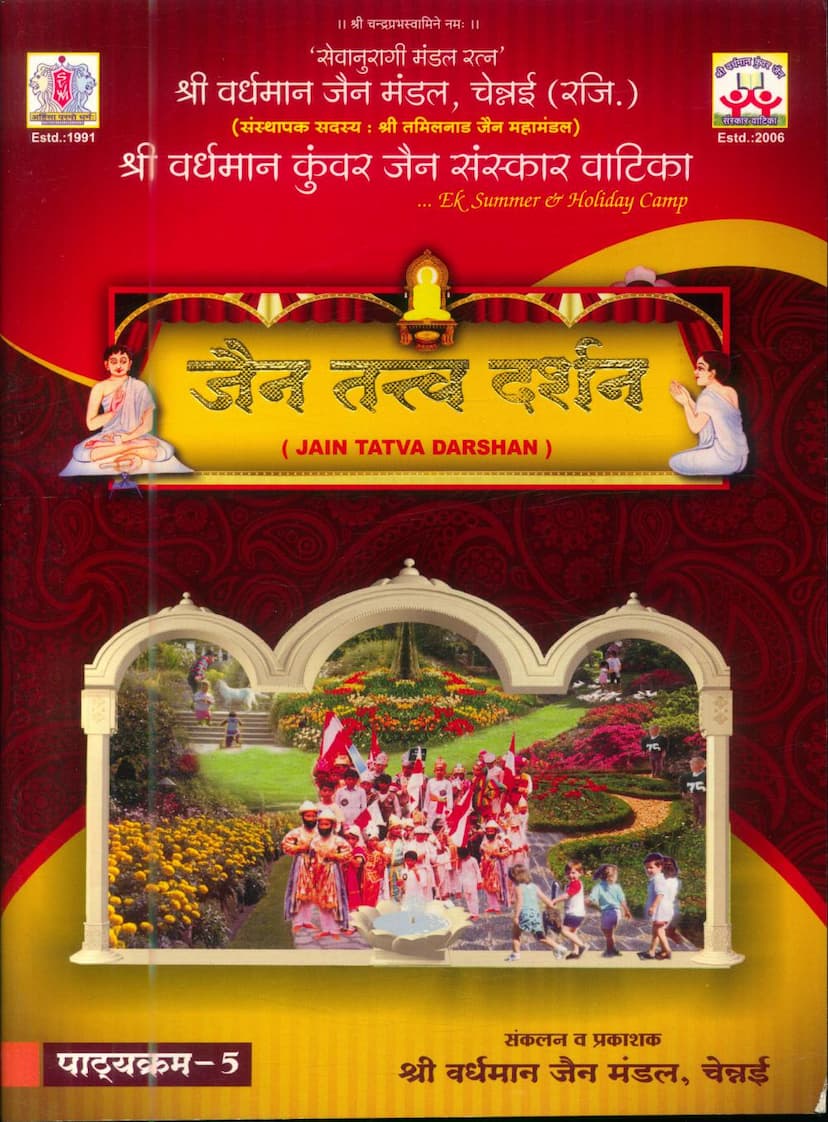Jain Tattva Darshan Part 05
Added to library: September 2, 2025

Summary
Here's a comprehensive summary of "Jain Tattva Darshan Part 05," based on the provided text:
Overall Purpose:
This book, "Jain Tattva Darshan Part 05," is a curriculum designed by the Vardhaman Jain Mandal, Chennai, specifically for children and youth to impart foundational knowledge of Jain principles, philosophy, and practices. It aims to cultivate deep faith and understanding of the Jain way of life, fostering spiritual growth and adherence to Jain ethics.
Key Themes and Content:
The book is structured into various sections, each covering essential aspects of Jainism. The core intent is to educate young minds, making complex philosophical concepts accessible through simple language, stories, and practical guidance.
-
The Legacy of Pandit Kuvarjibhai Doshi: The book is dedicated to the memory of Pandit Kuvarjibhai Doshi, a revered scholar and spiritual leader who spread Jain knowledge for 45 years in Chennai. His contributions to Tattva Gnana, Jyotish, Sanskrit, and Grammar are highlighted, emphasizing his role in initiating and guiding many towards the path of Jain conduct.
-
The Role of Sanskar Vatika: The "Sanskar Vatika" (Nursery of Values) initiated by Vardhaman Jain Mandal in 2006 is presented as a vital initiative to impart Jain values to children. It's described as a growing tree of knowledge, spreading its influence globally, aiming to make Jain children knowledgeable, disciplined, and deeply faithful.
-
Core Jain Principles and Practices:
- Tattva Gnana (Principle Knowledge): The book emphasizes the importance of "Samayagnana" (right knowledge) which leads to wisdom and discernment, helping individuals understand what to do, what not to do, what to speak, and what to think. It stresses that true knowledge guides one from darkness (ignorance) to light (wisdom).
- Understanding the Universe (Jain Geography): The text delves into the Jain cosmological view of the universe, including descriptions of oceans, continents, and geographical phenomena from a Jain perspective.
- Deities and Worship (Jain Puja Vidhi): Detailed descriptions of temple rituals, including the "Das Trik" (ten sets of practices), the significance of circumambulations (Pradakshina), salutations (Pranam), and various forms of worship (Ang Puja, Agra Puja, Bhav Puja). It highlights the importance of inner devotion (Bhav) alongside external rituals.
- The Path of Knowledge (Gyan): The book stresses the importance of attending the Jain "Pathshala" (religious school) for spiritual learning, contrasting it with secular education which may not impart true knowledge of the soul and dharma. It encourages continuous learning and devotion to knowledge.
- The Nine Principles (Nav Tattva): A comprehensive explanation of the nine fundamental tattvas in Jainism (Jiva, Ajiva, Punya, Pap, Ashrav, Samvar, Nirjara, Bandh, Moksha), explaining their meaning, classification, and the path to liberation. The analogy of a boat navigating a river is used to illustrate how understanding these principles helps one cross the ocean of worldly existence.
- The Qualities of the Soul (Jiva): Detailed explanation of the soul's nature, its various forms based on senses, life-span, intellect, and the concept of souls (Jivas) existing in different realms (hell, animal, human, celestial).
- Stories and Examples (Kahani): The book includes numerous stories of virtuous individuals, historical figures, and legends within Jainism, such as Bharat and Bahubali, Rohiniya Chor, Nayasar, Ilachikumara, Chandra and Sagar, and Khandak Mahamuni. These narratives serve as moral lessons and illustrate the consequences of actions.
- The Eight Karmas (Karma Siddhanta): A detailed explanation of the eight types of karmas (Jnanaavarniya, Darshanavarniya, Vedaniya, Mohaniya, Ayushya, Nam, Gotra, Antaray), their binding causes, and their effects on the soul. It categorizes them into "ghati" (destructive) and "aghatee" (non-destructive) karmas.
- The 18 Sources of Sin (18 Pap Sthanak): An enumeration and explanation of the eighteen primary sins in Jainism, such as violence (Pranaatipata), falsehood (Mridhvada), theft (Adattadana), lust (Maithuna), greed (Parigraha), anger (Krodh), pride (Maan), deceit (Maya), and illusion (Mithyatva Shalya).
- Dietary Restrictions (Bhojan Vivek): An extensive list of 22 forbidden foods (Abhakshya) and 32 types of foods containing infinite souls (Anantkaya), explaining why they are considered impure and the adverse effects of consuming them. This section emphasizes the importance of pure and mindful eating.
- Daily Conduct (Dincharya): The book outlines the 14 rules of conduct for a Jain householder (Shravak), covering aspects of diet, possessions, and daily activities.
- Reverence for Elders (Mata-Pita, Guru Vinay): A detailed explanation of 12 types of respectful conduct towards parents, gurus, and other respected individuals, highlighting the importance of gratitude and service.
- The Significance of Renunciation (Deeksha ki Mahatta): The book emphasizes the profound value of renunciation and spiritual commitment, illustrating it through stories and the teachings on the importance of detachment.
- The Five Great Vows (Pancha Mahavrata): While not explicitly detailed, the mention of Mahavrata in stories implies the foundational vows of Jainism.
- The Life of Tirthankaras: The book includes a section on the birth, enlightenment, and nirvana of the 24 Tirthankaras, providing their birthplaces and key life events.
- Practicing Jainism (Sutras and Vidhi): The book includes verses and methodologies for prayers, fasts (like Paushadh), and other religious practices.
- The Importance of Jain Geography: The book presents a Jain perspective on the earth's shape and the universe, challenging conventional scientific views with arguments for a flat earth and discussing concepts like the Bermuda Triangle from a Jain viewpoint.
-
Educational Approach: The book uses a question-and-answer format, stories, and descriptions to convey knowledge. It also includes sections for general knowledge and activities like drawing.
Overall Message:
"Jain Tattva Darshan Part 05" serves as a comprehensive guide for young Jains to understand and embrace their rich spiritual heritage. It instills the importance of right knowledge, conduct, and devotion, aiming to cultivate individuals who are not only knowledgeable in Jainism but also compassionate, ethical, and dedicated to spiritual progress. The book is a testament to the ongoing efforts of the Vardhaman Jain Mandal to nurture the next generation of Jain followers.